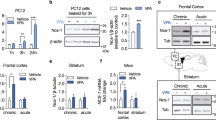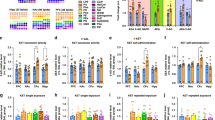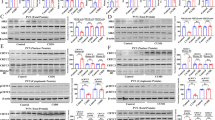Abstract
Chronic lithium and carbamazepine, which are effective against mania in bipolar disorder, decrease the activity of cytosolic phospholipase A2 (cPLA2) and the turnover rate of arachidonic acid in phospholipids in rat brain. Assuming that stages of bipolar disorder are related to brain arachidonic acid metabolism, we hypothesized that drugs effective in depression would increase cPLA2 activity. To test this hypothesis, adult male CDF-344 rats were administered fluoxetine (10 mg/kg intraperitoneally (i.p.) or saline (control) (i.p.) chronically for 21 days. Frontal cortex cPLA2 protein, phosphorylated cPLA2, activity and mRNA levels were increased after chronic fluoxetine. Transcription factors (activator protein-1, activator protein-2, glucocorticoid response element, polyoma enhancer element-3 and nuclear factor-kappa B) that are known to regulate cPLA2 gene expression were not significantly changed by chronic fluoxetine, but nuclear AU-rich element/poly(U)-binding/degradation factor-1 RNA-stabilizing protein was increased significantly. The results suggest that chronic fluoxetine increases brain cPLA2 gene expression post-transcriptionally by increasing cPLA2 mRNA stabilization. Chronic fluoxetine's effect on cPLA2 expression was opposite to the effect reported with chronic lithium or carbamazepine administration, and may be part of fluoxetine's mode of action.
This is a preview of subscription content, access via your institution
Access options
Subscribe to this journal
Receive 6 print issues and online access
$259.00 per year
only $43.17 per issue
Buy this article
- Purchase on Springer Link
- Instant access to full article PDF
Prices may be subject to local taxes which are calculated during checkout




Similar content being viewed by others
Abbreviations
- AP-1:
-
activator protein-1
- AP-2:
-
activator protein-2
- AUF:
-
AU-rich element/poly(U)-binding/degradation factor
- cPLA2:
-
cytosolic phospholipase A2
- iPLA2:
-
calcium-independent phospholipase A2
- MAPK:
-
mitogen-activated protein kinase
- PEA3:
-
polyoma enhancer element 3
- NF-κB:
-
nuclear factor kappa B
- sPLA2:
-
secretory phospholipase A2
- SSRI:
-
selective serotonin reuptake inhibitor
- 5-HT:
-
serotonin
References
Tohen M, Vieta E, Calabrese J, Ketter TA, Sachs G, Bowden C et al. Efficacy of olanzapine and olanzapine-fluoxetine combination in the treatment of bipolar I depression. Arch Gen Psychiatry 2003; 60: 1079–1088.
Goodwin GM . Evidence-based guidelines for treating bipolar disorder: recommendations from the British Association for Psychopharmacology. J Psychopharmacol 2003; 17: 149–173; discussion 147.
Benfield P, Heel RC, Lewis SP . Fluoxetine. A review of its pharmacodynamic and pharmacokinetic properties, and therapeutic efficacy in depressive illness. Drugs 1986; 32: 481–508.
Wong DT, Perry KW, Bymaster FP . Case history: the discovery of fluoxetine hydrochloride (Prozac). Nat Rev Drug Discov 2005; 4: 764–774.
Nierenberg AA . Do some antidepressants work faster than others? J Clin Psychiatry 2001; 62 (Suppl 15): 22–25.
Gardier AM, Malagie I, Trillat AC, Jacquot C, Artigas F . Role of 5-HT1A autoreceptors in the mechanism of action of serotoninergic antidepressant drugs: recent findings from in vivo microdialysis studies. Fundam Clin Pharmacol 1996; 10: 16–27.
Le Poul E, Laaris N, Hamon M, Lanfumey L . Fluoxetine-induced desensitization of somatodendritic 5-HT1A autoreceptors is independent of glucocorticoid(s). Synapse 1997; 27: 303–312.
Hjorth S, Auerbach SB . 5-HT1A autoreceptors and the mode of action of selective serotonin reuptake inhibitors (SSRI). Behav Brain Res 1996; 73: 281–283.
Dawson LA, Nguyen HQ, Smith DI, Schechter LE . Effects of chronic fluoxetine treatment in the presence and absence of (±)pindolol: a microdialysis study. Br J Pharmacol 2000; 130: 797–804.
Laakso A, Palvimaki EP, Kuoppamaki M, Syvalahti E, Hietala J . Chronic citalopram and fluoxetine treatments upregulate 5-HT2c receptors in the rat choroid plexus. Neuropsychopharmacology 1996; 15: 143–151.
Damjanoska KJ, Van de Kar LD, Kindel GH, Zhang Y, D'Souza DN, Garcia F et al. Chronic fluoxetine differentially affects 5-hydroxytryptamine (2A) receptor signaling in frontal cortex, oxytocin- and corticotropin-releasing factor-containing neurons in rat paraventricular nucleus. J Pharmacol Exp Ther 2003; 306: 563–571.
Tilakaratne N, Yang Z, Friedman E . Chronic fluoxetine or desmethylimipramine treatment alters 5-HT2 receptor mediated c-fos gene expression. Eur J Pharmacol 1995; 290: 263–266.
Massou JM, Trichard C, Attar-Levy D, Feline A, Corruble E, Beaufils B et al. Frontal 5-HT2A receptors studied in depressive patients during chronic treatment by selective serotonin reuptake inhibitors. Psychopharmacology (Berlin) 1997; 133: 99–101.
Ong WY, Sandhya TL, Horrocks LA, Farooqui AA . Distribution of cytoplasmic phospholipase A2 in the normal rat brain. J Hirnforsch 1999; 39: 391–400.
Murakami M, Kambe T, Shimbara S, Kudo I . Functional coupling between various phospholipase A2s and cyclooxygenases in immediate and delayed prostanoid biosynthetic pathways. J Biol Chem 1999; 274: 3103–3115.
Murakami M, Shimbara S, Kambe T, Kuwata H, Winstead MV, Tischfield JA et al. The functions of five distinct mammalian phospholipase A2S in regulating arachidonic acid release. Type IIa and type V secretory phospholipase A2S are functionally redundant and act in concert with cytosolic phospholipase A2. J Biol Chem 1998; 273: 14411–14423.
Akiba S, Mizunaga S, Kume K, Hayama M, Sato T . Involvement of group VI Ca2+-independent phospholipase A2 in protein kinase C-dependent arachidonic acid liberation in zymosan-stimulated macrophage-like P388D1 cells. J Biol Chem 1999; 274: 19906–19912.
Yang HC, Mosior M, Johnson CA, Chen Y, Dennis EA . Group-specific assays that distinguish between the four major types of mammalian phospholipase A2. Anal Biochem 1999; 269: 278–288.
Murakami M, Kudo I . Phospholipase A2. J Biochem (Tokyo) 2002; 131: 285–292.
Funk CD . Prostaglandins and leukotrienes: advances in eicosanoid biology. Science 2001; 294: 1871–1875.
Lands WEM, Crawford CG . Enzymes of membrane phospholipid metabolism. In: Marinosi A (ed). Plenum press: New York, 1976, pp 3–85.
Kam PC, See AU . Cyclo-oxygenase isoenzymes: physiological and pharmacological role. Anaesthesia 2000; 55: 442–449.
Leslie JB, Watkins WD . Eicosanoids in the central nervous system. J Neurosurg 1985; 63: 659–668.
O'Banion MK . Cyclooxygenase-2: molecular biology, pharmacology, and neurobiology. Crit Rev Neurobiol 1999; 13: 45–82.
Felder CC, Kanterman RY, Ma AL, Axelrod J . Serotonin stimulates phospholipase A2 and the release of arachidonic acid in hippocampal neurons by a type 2 serotonin receptor that is independent of inositolphospholipid hydrolysis. Proc Natl Acad Sci USA 1990; 87: 2187–2191.
Garcia MC, Kim HY . Mobilization of arachidonate and docosahexaenoate by stimulation of the 5-HT2A receptor in rat C6 glioma cells. Brain Res 1997; 768: 43–48.
Qu Y, Villacreses N, Murphy DL, Rapoport SI . 5-HT2A/2C receptor signaling via phospholipase A2 and arachidonic acid is attenuated in mice lacking the serotonin reuptake transporter. Psychopharmacology (Berlin) 2005; 180: 12–20.
Stout BD, Clarke WP, Berg KA . Rapid desensitization of the serotonin(2C) receptor system: effector pathway and agonist dependence. J Pharmacol Exp Ther 2002; 302: 957–962.
Hussain T, Lokhandwala MF . Dopamine-1 receptor G-protein coupling and the involvement of phospholipase A2 in dopamine-1 receptor mediated cellular signaling mechanisms in the proximal tubules of SHR. Clin Exp Hypertens 1997; 19: 131–140.
Hayakawa T, Chang MC, Rapoport SI, Appel NM . Selective dopamine receptor stimulation differentially affects [3H]arachidonic acid incorporation, a surrogate marker for phospholipase A2-mediated neurotransmitter signal transduction, in a rodent model of Parkinson's disease. J Pharmacol Exp Ther 2001; 296: 1074–1084.
Basselin M, Chang L, Bell JM, Rapoport SI . Chronic lithium chloride administration attenuates brain NMDA receptor-initiated signaling via arachidonic acid in unanesthetized rats. Neuropsychopharmacology 2005; Nov. 9.
Weichel O, Hilgert M, Chatterjee SS, Lehr M, Klein J . Bilobalide, a constituent of Ginkgo biloba, inhibits NMDA-induced phospholipase A2 activation and phospholipid breakdown in rat hippocampus. Naunyn Schmiedebergs Arch Pharmacol 1999; 360: 609–615.
Qu Y, Chang L, Klaff J, Seemann R, Rapoport SI . Imaging brain phospholipase A2-mediated signal transduction in response to acute fluoxetine administration in unanesthetized rats. Neuropsychopharmacology 2003; 28: 1219–1226.
Bazinet RP, Rao JS, Chang L, Rapoport SI, Lee HJ . Chronic carbamazepine decreases the incorporation rate and turnover of arachidonic Acid but not docosahexaenoic acid in brain phospholipids of the unanesthetized rat: Relevance to bipolar disorder. Biological Psychiatry 2006; 59: 401–407.
Chang MC, Contreras MA, Rosenberger TA, Rintala JJ, Bell JM, Rapoport SI . Chronic valproate treatment decreases the in vivo turnover of arachidonic acid in brain phospholipids: a possible common effect of mood stabilizers. J Neurochem 2001; 77: 796–803.
Chang MC, Grange E, Rabin O, Bell JM, Allen DD, Rapoport SI . Lithium decreases turnover of arachidonate in several brain phospholipids. Neurosci Lett 1996; 220: 171–174.
Ghelardoni S, Tomita YA, Bell JM, Rapoport SI, Bosetti F . Chronic carbamazepine selectively downregulates cytosolic phospholipase A2 expression and cyclooxygenase activity in rat brain. Biol Psychiatry 2004; 56: 248–254.
Rintala J, Seemann R, Chandrasekaran K, Rosenberger TA, Chang L, Contreras MA et al. 85 kDa cytosolic phospholipase A2 is a target for chronic lithium in rat brain. Neuroreport 1999; 10: 3887–3890.
Feder R . Fluoxetine-induced mania. J Clin Psychiatry 1990; 51: 524–525.
Ghaemi SN, Hsu DJ, Soldani F, Goodwin FK . Antidepressants in bipolar disorder: the case for caution. Bipolar Disord 2003; 5: 421–433.
Dean JL, Sully G, Clark AR, Saklatvala J . The involvement of AU-rich element-binding proteins in p38 mitogen-activated protein kinase pathway-mediated mRNA stabilisation. Cell Signal 2004; 16: 1113–1121.
Drevets WC . Prefrontal cortical–amygdalar metabolism in major depression. Ann NY Acad Sci 1999; 877: 614–637.
Uranova NA, Vostrikov VM, Orlovskaya DD, Rachmanova VI . Oligodendroglial density in the prefrontal cortex in schizophrenia and mood disorders: a study from the Stanley Neuropathology Consortium. Schizophr Res 2004; 67: 269–275.
Cotter D, Mackay D, Chana G, Beasley C, Landau S, Everall IP . Reduced neuronal size and glial cell density in area 9 of the dorsolateral prefrontal cortex in subjects with major depressive disorder. Cereb Cortex 2002; 12: 386–394.
Rajkowska G . Depression: what we can learn from postmortem studies. Neuroscientist 2003; 9: 273–284.
Drevets WC, Ongur D, Price JL . Neuroimaging abnormalities in the subgenual prefrontal cortex: implications for the pathophysiology of familial mood disorders. Mol Psychiatry 1998; 3: 220–226, 190–221.
Rao JS, Bazinet RP, Lee HJ, Rapoport SI . Mood stabilizers that downregulate the brain arachidonic acid cascade reduce AP-2 or NF-kB transcription factors in rat frontal cortex. Neuro Psychopharmacology – Supplement 44th ACNP Annual Meeting. Waikoloa, Hawaii, 2005.
Rao JS, Rapoport SI, Bosetti F . Decrease in the AP-2 DNA-binding activity and in the protein expression of AP-2 alpha and AP-2 beta in frontal cortex of rats treated with lithium for 6 weeks. Neuropsychopharmacology 2005; 30: 2006–2013.
Durand M, Berton O, Aguerre S, Edno L, Combourieu I, Mormede P et al. Effects of repeated fluoxetine on anxiety-related behaviours, central serotonergic systems, and the corticotropic axis axis in SHR and WKY rats. Neuropharmacology 1999; 38: 893–907.
Caccia S, Cappi M, Fracasso C, Garattini S . Influence of dose and route of administration on the kinetics of fluoxetine and its metabolite norfluoxetine in the rat. Psychopharmacology (Berlin) 1990; 100: 509–514.
Morri H, Ozaki M, Watanabe Y . 5′-Flanking region surrounding a human cytosolic phospholipase A2 gene. Biochem Biophys Res Commun 1994; 205: 6–11.
Tay A, Maxwell P, Li ZG, Goldberg H, Skorecki K . Cytosolic phospholipase A2 gene expression in rat mesangial cells is regulated post-transcriptionally. Biochem J 1994; 304 (Part 2): 417–422.
Borsch-Haubold AG, Bartoli F, Asselin J, Dudler T, Kramer RM, Apitz-Castro R et al. Identification of the phosphorylation sites of cytosolic phospholipase A2 in agonist-stimulated human platelets and HeLa cells. J Biol Chem 1998; 273: 4449–4458.
Hefner Y, Borsch-Haubold AG, Murakami M, Wilde JI, Pasquet S, Schieltz D et al. Serine 727 phosphorylation and activation of cytosolic phospholipase A2 by MNK1-related protein kinases. J Biol Chem 2000; 275: 37542–37551.
Mercier G, Lennon AM, Renouf B, Dessouroux A, Ramauge M, Courtin F et al. MAP kinase activation by fluoxetine and its relation to gene expression in cultured rat astrocytes. J Mol Neurosci 2004; 24: 207–216.
Coulon L, Calzada C, Moulin P, Vericel E, Lagarde M . Activation of p38 mitogen-activated protein kinase/cytosolic phospholipase A2 cascade in hydroperoxide-stressed platelets. Free Radic Biol Med 2003; 35: 616–625.
Nemenoff RA, Winitz S, Qian NX, Van Putten V, Johnson GL, Heasley LE . Phosphorylation and activation of a high molecular weight form of phospholipase A2 by p42 microtubule-associated protein 2 kinase and protein kinase C. J Biol Chem 1993; 268: 1960–1964.
Kucia K, Malecki A, Gabryel B, Trzeciak HI . Effect of antidepressants on the phospholipase A2 activity in plasma membranes of the rat brain cortex. Pol J Pharmacol 2003; 55: 5–15.
Qu Y, Chang L, Klaff J, Seemann R, Greenstein D, Rapoport SI . Chronic fluoxetine administration enchances brain phospholipase A2 signaling via arachidonic acid in unanesthetized rats. Eur J Pharmacol 2006; March 2.
Bazinet RP, Rao JS, Chang L, Rapoport SI, Lee HJ . Chronic valproate does not alter the kinetics of docosahexaenoic acid within brain phospholipids of the unanesthetized rat. Psychopharmacology (Berlin) 2005; 182: 180–185.
Chang MC, Bell JM, Purdon AD, Chikhale EG, Grange E . Dynamics of docosahexaenoic acid metabolism in the central nervous system: lack of effect of chronic lithium treatment. Neurochem Res 1999; 24: 399–406.
Bazinet RP, Weis MT, Rapoport SI, Rosenberger TA . Valproic acid selectively inhibits conversion of arachidonic acid to arachidonoyl-CoA by microsomal long-chain fatty acyl-CoA synthetases: Relevance to bipolar disorder. Psychopharmacology (Berlin) 2006; 1: 122–129.
Weerasinghe GR, Rapoport SI, Bosetti F . The effect of chronic lithium on arachidonic acid release and metabolism in rat brain does not involve secretory phospholipase A2 or lipoxygenase/cytochrome P450 pathways. Brain Res Bull 2004; 63: 485–489.
Koide H, Ogita K, Kikkawa U, Nishizuka Y . Isolation and characterization of the epsilon subspecies of protein kinase C from rat brain. Proc Natl Acad Sci USA 1992; 89: 1149–1153.
Abou-Samra AB, Catt KJ, Aguilera G . Biphasic inhibition of adrenocorticotropin release by corticosterone in cultured anterior pituitary cells. Endocrinology 1986; 119: 972–977.
Cambronero JC, Rivas FJ, Borrell J, Guaza C . Role of arachidonic acid metabolism on corticotropin-releasing factor (CRF)-release induced by interleukin-1 from superfused rat hypothalami. J Neuroimmunol 1992; 39: 57–66.
Pfennig A, Kunzel HE, Kern N, Ising M, Majer M, Fuchs B et al. Hypothalamus-pituitary-adrenal system regulation and suicidal behavior in depression. Biol Psychiatry 2005; 57: 336–342.
Giovacchini G, Chang MC, Channing MA, Toczek M, Mason A, Bokde AL et al. Brain incorporation of [11C]arachidonic acid in young healthy humans measured with positron emission tomography. J Cereb Blood Flow Metab 2002; 22: 1453–1462.
Giovacchini G, Lerner A, Toczek MT, Fraser C, Ma K, DeMar JC et al. Brain incorporation of 11C-arachidonic acid, blood volume, and blood flow in healthy aging: a study with partial-volume correction. J Nucl Med 2004; 45: 1471–1479.
El Yacoubi M, Bouali S, Popa D, Naudon L, Leroux-Nicollet I, Hamon M et al. Behavioral, neurochemical, and electrophysiological characterization of a genetic mouse model of depression. Proc Natl Acad Sci USA 2003; 100: 6227–6232.
Dulawa SC, Holick KA, Gundersen B, Hen R . Effects of chronic fluoxetine in animal models of anxiety and depression. Neuropsychopharmacology 2004; 29: 1321–1330.
De Foubert G, Carney SL, Robinson CS, Destexhe EJ, Tomlinson R, Hicks CA et al. Fluoxetine-induced change in rat brain expression of brain-derived neurotrophic factor varies depending on length of treatment. Neuroscience 2004; 128: 597–604.
Lucas KK, Dennis EA . Distinguishing phospholipase A2 types in biological samples by employing group-specific assays in the presence of inhibitors. Prostaglandins Other Lipid Mediat 2005; 77: 235–248.
Livak KJ, Schmittgen TD . Analysis of relative gene expression data using real-time quantitative PCR and the 2(−Delta Delta C(T)) Method. Methods 2001; 25: 402–408.
Acknowledgements
This research was supported by the Intramural Research Program of the NIH, NIA.
Author information
Authors and Affiliations
Corresponding author
Rights and permissions
About this article
Cite this article
Rao, J., Ertley, R., Lee, HJ. et al. Chronic fluoxetine upregulates activity, protein and mRNA levels of cytosolic phospholipase A2 in rat frontal cortex. Pharmacogenomics J 6, 413–420 (2006). https://doi.org/10.1038/sj.tpj.6500391
Received:
Revised:
Accepted:
Published:
Issue Date:
DOI: https://doi.org/10.1038/sj.tpj.6500391
Keywords
This article is cited by
-
Neuroplasticity and second messenger pathways in antidepressant efficacy: pharmacogenetic results from a prospective trial investigating treatment resistance
European Archives of Psychiatry and Clinical Neuroscience (2017)
-
Cell type-specific in vivo expression of genes encoding signalling molecules in the brain in response to chronic mild stress and chronic treatment with fluoxetine
Psychopharmacology (2015)
-
PPP3CC gene: a putative modulator of antidepressant response through the B-cell receptor signaling pathway
The Pharmacogenomics Journal (2014)
-
Cell Type-Specific Gene Expression and Editing Responses to Chronic Fluoxetine Treatment in the In Vivo Mouse Brain and Their Relevance for Stress-Induced Anhedonia
Neurochemical Research (2012)
-
Increased excitotoxicity and neuroinflammatory markers in postmortem frontal cortex from bipolar disorder patients
Molecular Psychiatry (2010)



